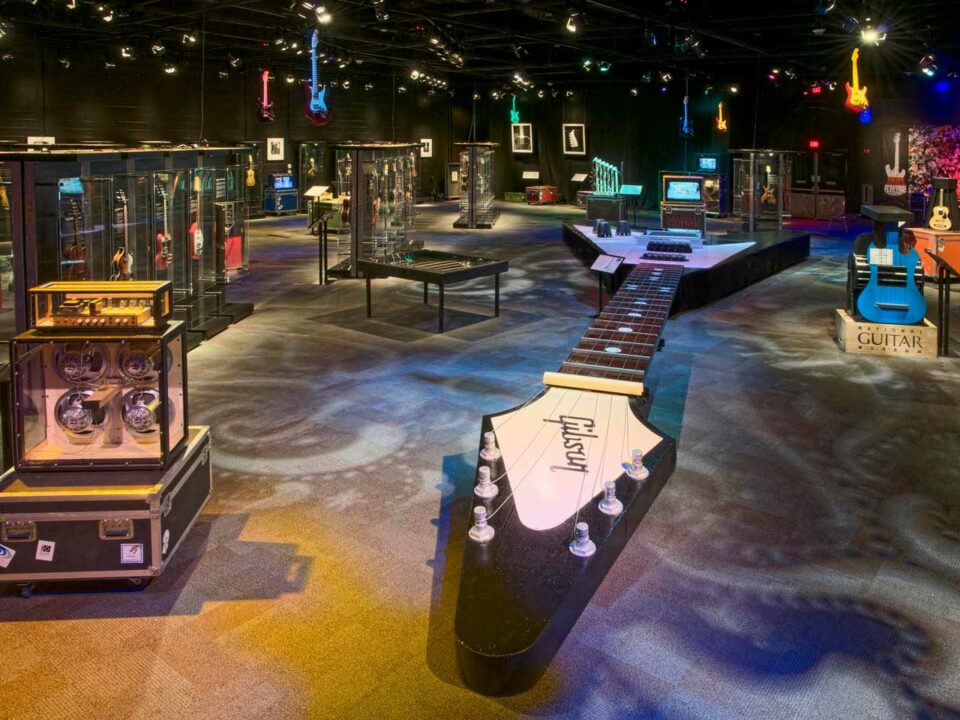
5 Things Kids Can Learn About at GUITAR
The latest exhibit at the Denver Museum of Nature & Science is sure to rock your world.
Visitors to the new Denver Museum of Nature & Science (DMNS) exhibit GUITAR: The Instrument That Rocked the World don’t need to be music aficionados to appreciate its offerings: an expansive collection of more than 70 instruments ranging from rare and antique to modern, pop-culture designs. There’s something for everyone in this one-of-a-kind exhibit featuring history and STEAM concepts like sound waves, frequency, mathematical scales, and engineering through a wide range of hands-on experiences—plus the world’s largest playable guitar, measuring longer than two trucks (43.5 feet) and weighing as much as a car.
“So many people have a guitar story: They love guitar music; have a friend, partner, family member who plays; or have always had a heart for that guitar in the basement, on which they played a few chords long ago,” says Jennifer Moss Logan, DMNS experience developer and GUITAR exhibition educator. “It’s just such an accessible instrument…anyone who is new to it can just pick it up, strum the chords, and feel the richness of the guitar.”
Here are five lessons Guitar can teach kids and their grownups about the world’s most popular instrument:
• Versions of the guitar have emerged over centuries
It’s tough to comprehend the instrument’s popularity until you see the varieties that have evolved over thousands of years. View the earliest guitar versions in this exhibit, including the tanbur—a slender-necked, two-stringed style—estimated to have been developed around 3,000 B.C. in Persia (modern-day Iraq). The pear-shaped oud (rhymes with “food”) is from the same era, a North African style featuring three elaborately adorned sound holes. There’s also the vihuela (1400s), thought to be the earliest model resembling today’s guitar, created on the Iberian Peninsula. And don’t miss the charango, a South American instrument whose original versions in the 1700s featured a sound box made with the shell of the native armadillo, called a “quirquincho.”
• Scientific factors affect the guitar’s sound.
“Stealth science,” as Moss Logan calls it, is featured throughout the exhibit. For instance: How do strings vibrate? How does an electric guitar pickup work? What’s inside the sound box of an acoustic guitar? What differences do different woods make? Visitors can see for themselves by shortening lengths of guitar strings to see how it affects tones (shorter = higher tones) or by using a mallet to create different sounds on plywood, rosewood, and mahogany. You can even pluck strings of varying materials—catgut (actually, dried sheep intestine, which was used until the mid-1900s), steel, or nylon—to compare sounds.

• Guitar makers are artists, too.
Known as “luthiers,” whose earliest masterpieces were the lute, today’s artisans are just as revered among musicians as they have been for centuries. And it’s easy to appreciate that artistry by perusing the endless display cases filled with fruits of their labor, from the Beatle Bass made famous by Paul McCartney to the neon-green Ibanez Jem electric guitar that’s similar to one played by Steve Vai of Whitesnake. Another Ibanez, the Iceman, was played by Paul Stanley of KISS (especially intriguing to my guitar-playing son, Brody). Don’t miss an eight-necked “Rock Ock,” the world’s largest playable multi-necked instrument. Be sure to also check out the luthier’s workbench, created by famed archtop guitar builder Robert Benedetto, whose work is especially popular among jazz artists.
• Electricity changed everything about guitars.
Most modern-day guitar enthusiasts associate the instrument with favorite rock ‘n’ roll tunes blaring from home or car speakers. But for centuries, they were only played in quiet settings to accompany singers or dancers. It wasn’t until the 1900s when guitarists began playing alongside louder instruments like trumpets and drums. Guitar makers tried to make sounds louder by adjusting body elements or adding steel strings, but nothing made them loud enough until the advent of amplifiers and electric guitars. Learn about one of the earliest versions of the latter: the Rickenbacker A-22, aka “Frying Pan,” produced from 1932 to 1958. Find out the science behind the amplifier, which “picks up” electrical signals via the “pickup” on a guitar and strengthens the sound to the level we’ve become accustomed to within the last century.
• Fame is right at your fingertips.
Kids will see that guitar skill—even fame—is right here in our state. The stories of successful musicians who call Colorado home are on display, including jazz guitarist and composer Bill Frisell, and experimental guitarist Janet Feder, who plays guitar with rulers, rocks, metal rings, and rubber balls to change the sound of her guitar. There’s also El Javi, who blends flamenco, rock, and bluegrass into his music; the members of the well-known band, Big Head Todd and the Monsters, met at Columbine High School.
What’s more, kids can actually play guitars in the exhibition’s Jam Room, a feature that’s unique to the Denver exhibit. Try acoustic and electric guitars in left- or right-handed versions, or try a lap steel guitar, which uses a metal slider to play different chords.
Need to Know: GUITAR: The Instrument That Rocked the World is on display at Denver Museum of Nature & Science through April 17, 2022. The exhibition is included with general admission. Timed tickets are required for museum entry.





